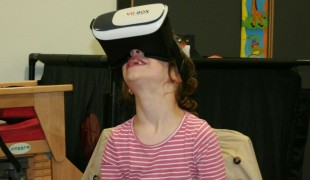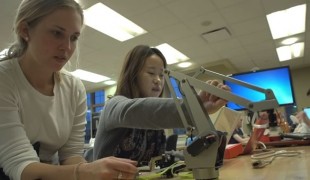Browse solutions by symptom
Browse posts by symptom
60 solutions
-
-
421
-
2
-
6831

Dad uses virtual reality to help his daughter who suffers from Williams Syndrome
COMMUNICATION: Communicating, whether by speaking, listening, or other means
Social interaction
foetal alcoholic syndrome
DiGeorge Syndrome
Angelman Syndrome
Neuromuscular Disorders
Assistive Technology access
App (Including when connected with wearable)
Difficulty coordinating movements
Difficulty speaking or understanding speech
Trouble with fine motor skills (e.g., writing, buttoning clothes)
Cognitive impairment
Memory loss
Anxiety
Sensitivity to light or sound
Depression or anxiety
Managing Neurological Disorders
Improving Speech and Communication
Caregiving Support
Medical Genetics
Neurology
Pediatrics
United Kingdom
-
-
-
468
-
0
-
6797

Cerebral palsy patient creates app to help disabled people communicate
COMMUNICATION: Communicating, whether by speaking, listening, or other means
Social interaction
Cerebral Palsy
Speech Disorder
Neuromuscular Disorders
App (Including when connected with wearable)
Difficulty speaking or understanding speech
Managing Neurological Disorders
Improving Speech and Communication
Neurology
Ireland
-
-
-
428
-
0
-
6724

Boy invents software to help his grandmother regain cognitive functions
CAREGIVING
Social interaction
Brain Stroke
Paralysis
Brain Injury (Abscess, Brain Barrier Defect, Brain Contusion, Brain Hemorrhage, Brain Edema)
App (Including when connected with wearable)
Paralysis of the legs and lower body
Difficulty speaking or understanding speech
Memory loss
Enhancing Mental Health
To improve Treatment/Therapy
Caregiving Support
Intensive Care Medicine
Neurology
United States
-
-
-
254
-
1
-
2915

Mother invents drone to help track her autistic child
CAREGIVING
COMMUNICATION: Communicating, whether by speaking, listening, or other means
Autism
Alzheimer's Disease
Assistive Daily Life Device (to help ADL)
Assistive Technology access
Anxiety
Difficulty concentrating or making decisions
Difficulty coordinating movements
Muscle weakness
Loss of balance
Social withdrawal or isolation
Difficulty speaking or understanding speech
Memory loss
Irritability or anger outbursts
Confusion
Restlessness or feeling slowed down
Sleep disturbances
Loss of interest or pleasure in activities (anhedonia)
Mood swings
Sensitivity to light or sound
Fatigue
Managing Neurological Disorders
Preventing (Vaccination, Protection, Falls, Research/Mapping)
Caregiving Support
Child and Adolescent Psychiatry
General and Family Medicine
Neurology
Pediatrics
Psychiatry
United States
-
-
-
512
-
0
-
8082

Students create way to help girl who was struck by lightning eat by herself
(SELF)-CARE: EATING: Eating independently.
(SELF)-CARE: DRINKING: Drinking independently.
Brain Injury (Abscess, Brain Barrier Defect, Brain Contusion, Brain Hemorrhage, Brain Edema)
Paralysis
Cervical spinal cord injury/Tetraplegia
Assistive Daily Life Device (to help ADL)
Assistive Technology access
Muscle cramps or spasms
Difficulty coordinating movements
Stiffness or rigidity (difficulty moving)
Paralysis of the legs and lower body
Muscle weakness
Difficulty speaking or understanding speech
Memory loss
Restoring mobility
Replacing lost limbs
Managing Neurological Disorders
Neurology
United States
-
-
-
471
-
0
-
8211

Student creates app to improve post-stroke care inspired by his uncle
COMMUNICATION: Communicating, whether by speaking, listening, or other means
CAREGIVING
Brain Stroke
Brain Injury (Abscess, Brain Barrier Defect, Brain Contusion, Brain Hemorrhage, Brain Edema)
Stroke
App (Including when connected with wearable)
Chest pain or discomfort
Difficulty coordinating movements
Stiffness or rigidity (difficulty moving)
Paralysis of the legs and lower body
Muscle weakness
Difficulty speaking or understanding speech
Memory loss
Confusion
Fatigue
Dizziness or lightheadedness
Numbness or weakness in the legs
Irregular heartbeat (arrhythmia)
Cold hands or feet
Rapid heartbeat (tachycardia)
Vertigo
Swelling/edema of the legs or ankles.
Shortness of breath
Chest tightness/pressure
Rehabilitating After Stroke
Managing Neurological Disorders
Improving Speech and Communication
To improve Treatment/Therapy
Cardiology
General and Family Medicine
Neurology
United States
-
-
-
248
-
0
-
3598

Brother creates app to help his sister communicate
-
-
-
505
-
0
-
9196

Former disabled musician invents special bass guitar
Playing an instrument
Spinal Cord and Nerve Root Disorders
Brain Stroke
Stroke
Brain Injury (Abscess, Brain Barrier Defect, Brain Contusion, Brain Hemorrhage, Brain Edema)
Walking Aid (wheelchair/walker/crutches)
App (Including when connected with wearable)
Chest pain or discomfort
Muscle cramps or spasms
Difficulty coordinating movements
Stiffness or rigidity (difficulty moving)
Paralysis of the legs and lower body
Muscle weakness
Difficulty speaking or understanding speech
Fatigue
Dizziness or lightheadedness
Numbness or weakness in the legs
Fainting or loss of consciousness
Irregular heartbeat (arrhythmia)
Cold hands or feet
Rapid heartbeat (tachycardia)
Swelling/edema of the legs or ankles.
Shortness of breath
Chest tightness/pressure
Promoting self-management
Promoting inclusivity and social integration
Cardiology
General and Family Medicine
Intensive Care Medicine
Neurology
United Kingdom
-
-
-
611
-
2
-
14994

Vocal Eyes Becker Communication System
COMMUNICATION: Communicating, whether by speaking, listening, or other means
Social interaction
Amyotrophic Lateral Sclerosis
Multiple Sclerosis
Neuromuscular Disorders
Speech Disorder
Muscle Tone Abnormalities weakness
Assistive Daily Life Device (to help ADL)
Muscle cramps or spasms
Difficulty coordinating movements
Stiffness or rigidity (difficulty moving)
Paralysis of the legs and lower body
Muscle weakness
Difficulty speaking or understanding speech
Managing Neurological Disorders
Improving Speech and Communication
Neurology
United States
-
 en
en